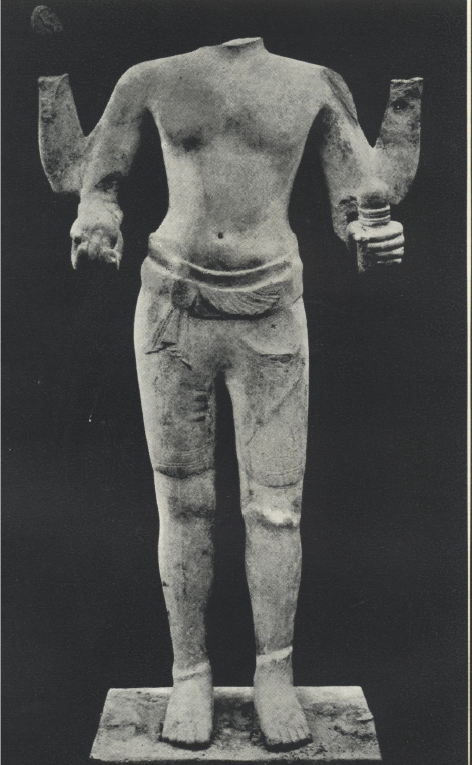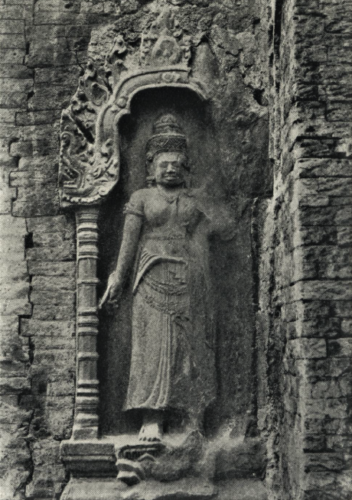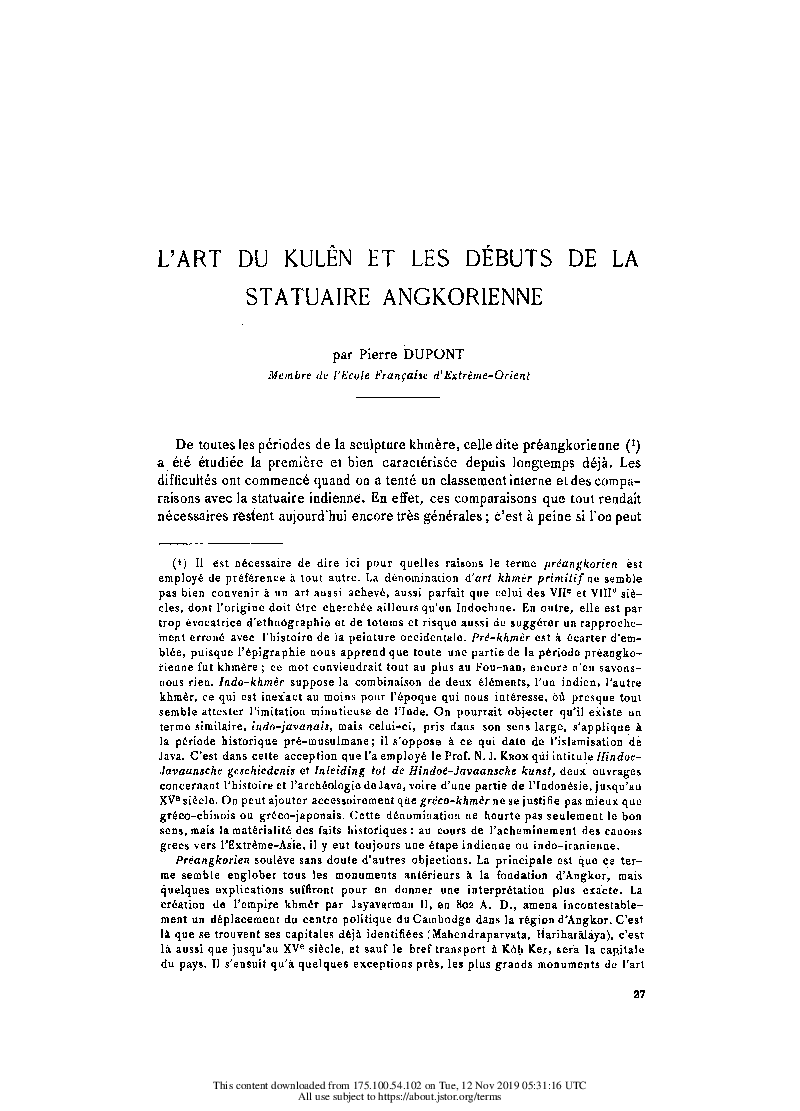L'art du Kulen et les débuts de la statuaire angkorienne / Kulen Art and the Origins of Angkorian Statuary
by Pierre Dupont
When a specifically Khmer statuary art, distinct from mere Indian sculpture replicas, started to emerge.

Publication: Bulletin de l'École française d'Extrême-Orient, Vol. 36, No. 2, pp. 415-426
Published: 1936
Author: Pierre Dupont
Pages: 32
Language : French
pdf 3.4 MB
As early as 1936, eminent art historian Pierre Dupont found the origins of Angkorian statuary art on the hills of Phnom Kulen, where it was then supposed that the Royal Palace of Mahendraparvata have stood, an hypothesis confirmed by posterior archeological findings and Lidar prospection.
In this essay, the author stresses that all the statues found at Prasat Damrei Krap and Prasat Ko, two royal temples from the 9th century, are representations of Vishnu, noting that the typical Kulen Vishnu is ‘standing, with a mitre and four arms holding a disk, a conch, a ball and a club’. He also remarks that ‘even if this is without doubt a Vishnu image, the style does not appear in the list of sthânaka murti established by Gopinatha Rao’ in the latter’s Elements of Hindu Iconography.
Also of note: while he acknowledges Indo-Javanese influences — quoting Gilberte de Coral-Rémusat, the author does not mention the impact of Champa art on this pre-Angkorian style, later identified by art historians.
Note: regarding the notion of “pre-Angkorian” art, Pierre Dupont adds this interesting clarification: ‘Préangkorien soulève sans doute des objections, la principale étant que ce terme semble englober tous les monuments antérieurs à la fondation d’Angkor, mais quelques explications suffiront pour en donner une interprétation plus exacte. La création de l’empire khmèr par Jayavarman II, en 802 A. D., amena incontestablement un déplacement du centre politique du Cambodge dans la région d’Angkor. C’est là que se trouvent ses capitales déjà identifiées (Mahendraparvata, Hariharâlaya), c’est là aussi que jusqu’au XVe siècle, et sauf le bref transport à Kòh Ker, sera la capitale du pays. Il s’ensuit qu’à quelques exceptions près, les plus grands monuments khmèr et les plus représentatifs se trouvent réunis sur une faible partie de la province de Siemréap ayant Angkor pour centre. Le terme angkorien employé pour définir la période incluse entre le IXe et le XVe siècle se justifie donc surabondamment. A l’époque antérieure, nous trouvons de nombreux édifices d’importance très inégale, surtout dispersés à travers le Sud du Cambodge et la Cochinchine ; on en connaît très peu dans la région d’Angkor (parties anciennes d’Ak Yom et de Trapän Phoñ). De plus, il a existé alors une profusion de capitales diverses, Vyâdhapura, Çambhupura, Çresthapura, etc., sans compter celles que nous ignorons. Aussi, faute de dénomination géographique ou historique acceptable, le mieux est-il de considérer globalement ces monuments comme antérieurs au temps où le centre politique et artistique du Cambodge fut localisé dans la région d’Angkor, soit préangkoriens.’
Photos: Vishnu statue at Prasat Damrei Krap, Kulen (then kept at Musée L. Finot in Hanoi); below, Devata at Prasat Ko, Kulen, in 1936.

Tags: Kulen Mountain, Mahendraparvata, statuary, art history, pre-Angkorean
About the Author

Pierre Dupont
Specialized in pre-Thai polities, archeologist and art historian Pierre Dupont (1908, Paris ‑1955, Bangkok) has particularly studied the Mon kingdom of Dvaravati which predated the Sukhothai, Chiang Mai or Ayutthaya kingdoms that thrieve between the 13th and the 15 centuries.
First at École du Louvre, then with the Musée Guimet in Paris, the French Institute in Amsterdam and Berlin, he developed a vast knowledge of Javanese and Southeast Asian arts. Joining EFEO in January 1936, he worked extensively in Angkor, the Kulen plateau and modern Thailand. With Victor Goloubew, he studied Muong rituals associated with the bronze drums. With Gilberte de Coral-Rémusat, he took part in the archaeological mission led by Philippe Stern to Angkor and Kulen.
After researching Khmer inscriptions, Pierre Dupont prospected two important sites related to Dvaravati civilization in Thailand, Nakon Pathom and Kok Vat. In the 1940’s, he was Curator of the Phnom Penh National Museum (then Musée Albert-Sarrault) and Secretary of the Buddhist Institute, before being arrested by the Japanese occupation forces.
After leaving EFEO for the CNRS in 1950, he became Direction of Institut de Civilisation Indienne in 1954 and carried on various missions in India, Sri Lanka and Southeast Asia.

